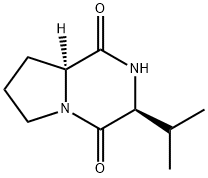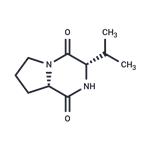Cyclo(L-Pro-L-Val) is a diketopiperazine that has been found in the marine sponge T. ignis, the bacterium B. pumilus, and the fungus A. fumigatus, among others. It is active against the bacteria S. aureus and B. subtilis (MICs = 16.3 and 18.2 μg/ml, respectively) but not E. coli (MIC = >20 μg/ml). Cyclo(L-Pro-L-Val) inhibits activation of a LuxR-dependent E. coli biosensor by the quorum-sensing molecule 3-oxo-hexanoyl-homoserine lactone (IC50 = 0.4 mM) and activates violacein pigment production in the LuxR-dependent C. violaceum acyl homoserine lactone reporter strain CV026. However, it does not activate or inhibit lacZ-based reporter fusions in S. liquefaciens or A. tumefaciens.
Cyclo(L-prolyl-L-valyl) is a metabolite found in various marine fungi and bacteria. It is a diketopiperazine derivative isolated from Bacillus thuringiensis and Bacillus endophyticus.
Cyclo(L-Pro-L-Val) is a diketopiperazine formed by the fusion of valine and proline, reported as a secondary metabolite of fungi and bacteria. In Pseudomonas aeruginosa, cyclo(L-Pro-L-Val) is capable of activating N-acylhomoserine lactones (AHLs). Cyclo(L-Pro-L-Val) is also capable of activating or antagonizing other LuxR-based quorum-sensing systems. While the mode of action of the cyclo(L-Pro-L-Val) is not known, its activity suggests the existence of cross talk among bacterial signalling systems.
ChEBI: Cyclo(L-Pro-L-Val) is a piperazinone. It has a role as a metabolite.


